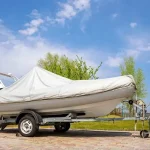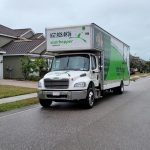Introduction
Are you tired of the physical strain and hassle of manually cranking your boat onto its trailer? The struggle at the boat ramp can quickly sour a perfect day on the water. An electric boat winch is the ultimate upgrade to your setup, transforming a difficult task into a simple, button-push operation. This powerful tool saves you time, energy, and potential back pain, significantly enhancing your entire boating experience. Say goodbye to the hand crank and hello to effortless loading and unloading. When considering an electric boat winch in Australia, some reliable brands to look for include Jarrett, Powerwinch, Fulton, and Trailer Winch. These brands are known for their durability, ease of use, and consistent performance in a variety of Australian boating conditions.
Understanding Electric Boat Winches
An electric boat winch is a mechanical device that uses a motor to load your boat onto a trailer, eliminating manual effort. It makes the process faster and easier, especially with heavy boats, offering far greater convenience than manual winches.
Let’s look at how these devices work.
What Is an Electric Boat Winch?
An electric boat winch mounts to your trailer and uses a motor to pull your boat from the water, replacing manual cranking with push-button convenience. Powered by your vehicle’s 12-volt battery, it provides consistent force for hauling even heavy boats. This automation makes loading easier, safer, and more efficient, letting you spend less time at the ramp and more time on the water.
How Electric Boat Winches Work
An electric boat winch operates simply: activating it draws power from your boat or vehicle’s electrical system to run the motor, which engages gears and turns the drum. As the drum rotates, it spools the cable or rope, pulling your boat onto the trailer.
Winch capacity determines the maximum safe load. This automated process replaces manual cranking with push-button control, while the gear ratio provides enough torque for heavy loads.
The system saves effort and gives you precise control—letting you start, stop, or reverse instantly for perfect boat alignment and secure transport.
Key Features to Look for in an Electric Boat Winch
Selecting the right winch is crucial for safe and efficient operation. Focus on key features like load capacity, material quality, and control options to match your boat’s weight and your ease-of-use preferences.
Below, we’ll examine these features to help you choose the best electric winch.
Load Capacity and Suitability for Different Boats
The most important winch feature is load capacity—the maximum weight it can safely pull. For your boat, choose a winch rated at least 1.5 to 2 times its total weight (including engine, fuel, and gear) to ensure safe operation.
Select a winch suited for your largest vessel; overloading is dangerous and risks equipment failure.
Consider:
- Total Boat Weight: Include engine, fuel, water, and gear.
- Ramp Incline: Steeper ramps need more pulling power.
- Friction: Trailer bunks or rollers affect the required capacity.
- Safety Margin: Pick a winch with extra capacity above your estimate.
Material Quality and Corrosion Resistance
For marine use, winch material quality and corrosion resistance are essential. Choose winches with stainless steel or durable protective coatings for long service life and reliability. Key components—drum, gears, and housing—should withstand moisture and prevent rust, especially in saltwater environments. Well-sealed motors and gearboxes protect against water damage.
Steel cables offer strength but can rust if not maintained; synthetic ropes are lighter, rustproof, and easier to handle, making them ideal for marine settings.
Controls and Remote Operation Options
An electric winch’s main advantage is its easy operation, especially with versatile control options. Most models include a wired controller, while many also feature a wireless remote for flexible, distance operation. This lets you position yourself for the best view and alignment of your boat and trailer, improving safety and convenience. Some advanced winches offer both control types as backup.
When choosing controls, look for:
- Responsive Buttons: Quick and easy to press.
- Durable Housing: Withstands drops and water exposure.
- Good Range: Reliable operation from various spots around the ramp.
Installation Insights for Electric Boat Winches
Installing a new electric boat trailer winch is manageable for most boat owners. Most winches fit standard trailer mounts, often matching the manual winch’s bolt pattern. Installation involves securing the winch and connecting it to a power source. Follow the manufacturer’s instructions closely.
Key considerations are trailer compatibility and basic electrical wiring.
Compatibility with Trailers and Mounting Points
Before buying an electric winch, ensure it fits your boat trailer. Measure your trailer’s bolt pattern and compare it to the winch specifications for a secure fit. If the holes don’t align, use an adapter plate. Mount the winch with high-grade hardware tightened to proper torque, as it will handle heavy loads.
Align the winch so the cable pulls straight from your boat’s bow eye to the drum. Misalignment can cause uneven spooling and damage. Using the correct installation equipment ensures safety and optimal performance.
Electrical Requirements and Wiring Basics
Connecting your electric winch to power is the final installation step. Most boat winches run on 12-volt DC from your tow vehicle’s battery. Secure connections are vital for reliable operation and safety.
Use the included wiring harness to route positive and negative leads from the winch to the battery, keeping them clear of sharp edges and hot engine parts. Always install an inline fuse or circuit breaker on the positive wire as recommended.
Basic wiring overview:
| Component | Connection Point | Purpose |
| Red (Positive) Wire | Battery positive terminal | Powers winch motor |
| Black (Negative) Wire | Battery negative terminal or chassis | Completes circuit |
| Wiring Harness | Between winch and battery leads | Easy connection/disconnection |
| Circuit Breaker/Fuse | Inline on positive wire | Protects against surges |
Safety Tips for Operating Electric Boat Winches
An electric winch offers convenience but requires careful handling. Safety procedures are essential to prevent accidents and operate your winch confidently. Overload protection helps, but user awareness is crucial—always stay alert, especially at busy boat ramps.
Follow these tips to prevent accidents and safely retrieve your boat.
Preventing Accidents and Equipment Damage
Safety is paramount when operating an electric winch. Always stay within the winch’s rated capacity by knowing your boat’s total weight.
Inspect the winch cable or rope regularly for fraying, kinks, or broken strands, and replace any damaged line immediately. Keep hands and clothing away from the drum and cable during operation.
Key safety rules:
- Never use the winch to lift or move people.
- Stand clear of the cable’s direct line to avoid injury if it snaps.
- Do not disengage the clutch while under load.
- Place a damper or heavy blanket over the cable to reduce backlash risk.
Best Practices for Secure Boat Retrieval
For smooth and secure boat retrieval, position your trailer so the boat can be loaded straight. Once partially on, attach the snap hook securely to the bow eye and ensure its latch is closed.
Use the winch to guide and center the boat on the trailer bunks or rollers; a wireless remote helps with visibility. Winch until the bow rests firmly against the bow stop.
Never rely solely on the winch for transport. Always use safety chains or heavy-duty transom straps to secure the boat, ensuring it’s safe on the road.
Maintenance and Care for Long-Term Performance
Regular maintenance keeps your electric boat winch reliable and extends its lifespan. Simple cleaning and inspection after each use prevent premature wear and ensure it’s always ready.
Here’s how to clean your winch and fix common issues.
Cleaning and Inspecting the Winch Mechanism
Clean and inspect your winch regularly to keep it in good condition. After each use—especially in saltwater—rinse the winch with fresh water to remove salt, sand, and grime that cause corrosion. Focus on the drum and cable or rope.
Periodically, inspect thoroughly by unspooling the cable and checking for fraying, flat spots, or rust. Confirm the winch is securely mounted and all electrical connections are clean and tight.
Inspection checklist:
- Rinse with fresh water: After every use.
- Inspect the line: Look for frays, kinks, or damage.
- Check electrical connections: Ensure they’re clean and tight.
- Test the motor: Run briefly in both directions.
- Lubricate moving parts: If recommended by the manufacturer.
Troubleshooting Common Issues
Even with a quality winch, issues can arise—most commonly, power failure. If your winch won’t operate, first check that your vehicle’s battery is charged and all electrical connections are secure.
Next, inspect the inline fuse or circuit breaker; a blown fuse often stops the winch. If the motor clicks but doesn’t turn, you may have a weak battery or a faulty solenoid.
Uneven line spooling usually indicates improper setup or a worn fairlead. Make sure the line winds tightly and evenly across the drum. For ongoing electrical or motor problems, consult the manufacturer’s guide or seek professional help.
Conclusion
Upgrading to an electric boat winch enhances both convenience and safety on the water. Understanding key features, installation, and maintenance ensures efficient, long-lasting operation. Always follow best practices and inspect your equipment regularly for optimal safety. Choose the right electric winch to elevate your boating experience—explore our selection today!
Frequently Asked Questions
Can one electric boat winch handle multiple boat sizes?
Yes, an electric boat winch can handle multiple boat sizes, provided its winch capacity is rated for the heaviest boat you own. Always choose the right winch based on the weight of your largest vessel to ensure safe operation. A heavy-duty winch will have no problem with a smaller boat.
Are electric boat winches suitable for portable use?
Electric boat winches are generally not designed for portable use. They require a secure mounting point on a trailer and a stable power source, like a vehicle’s battery. For true portability, a lightweight manual winch or a smaller, specialized portable winch may be more practical due to their ease of use without a fixed power source.
Do electric boat winches require frequent servicing?
Electric winches do not typically require frequent professional servicing, but they do need regular maintenance. Keeping the mechanical device clean, inspecting for signs of wear, and ensuring electrical connections are in good condition will keep it performing reliably. This simple care routine prevents most major issues.






